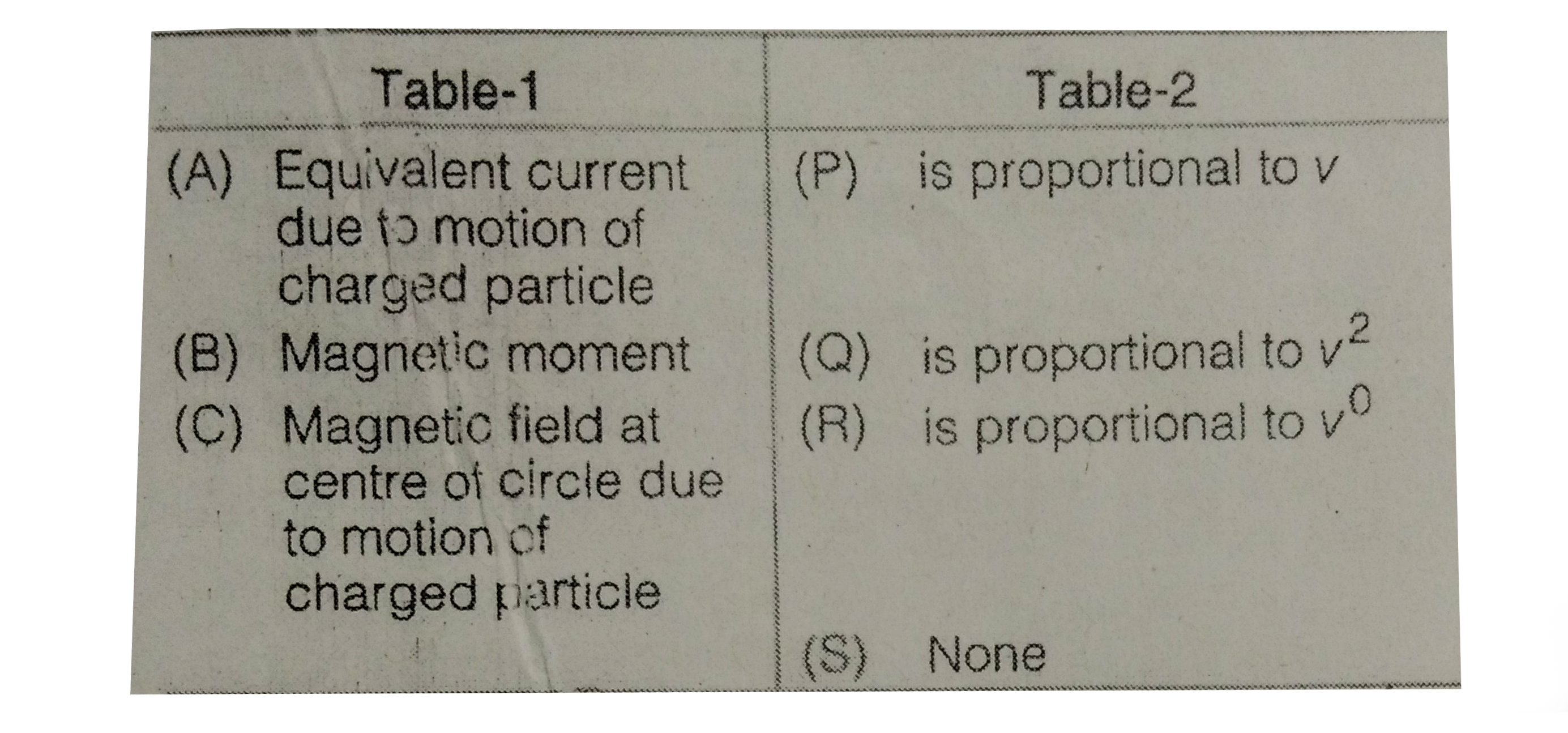A charged particle moves in a uniform magnetic field perpendicular to it, with a radius of curvature 4 cm. On passing through a metallic sheet it loses half of its kinetic energy. Then, the radius of curvature of the particle is
2cm
4cm
8cm
2√2cm
The correct Answer is:d
To solve the problem step by step, we will use the relationship between the radius of curvature of a charged particle moving in a magnetic field and its kinetic energy.
Step 1: Understand the relationship between radius of curvature and kinetic energy
The radius of curvature R of a charged particle moving in a magnetic field is given by the formula:
R=mvQB
where:
- m is the mass of the particle,
- v is the velocity of the particle,
- Q is the charge of the particle,
- B is the magnetic field strength.
Step 2: Express velocity in terms of kinetic energy
The kinetic energy KE of the particle is given by:
KE=12mv2
From this, we can express the velocity v as:
v=√2KEm
Step 3: Substitute velocity in the radius of curvature formula
Substituting the expression for v into the radius of curvature formula:
R=m√2KEmQB=√2m⋅KEQB
Step 4: Establish the relationship between initial and final kinetic energy
Let KE1 be the initial kinetic energy and KE2 be the final kinetic energy after the particle passes through the metallic sheet. According to the problem, the particle loses half of its kinetic energy:
KE2=12KE1
Step 5: Relate the radii of curvature before and after the energy loss
Using the relationship derived earlier, we can express the ratio of the radii of curvature in terms of kinetic energy:
R1R2=√KE1√KE2
Substituting KE2:
R1R2=√KE1√12KE1=√KE1√KE1⋅1√2=√2
Step 6: Solve for the final radius of curvature
Given that R1=4cm:
4R2=√2
Cross-multiplying gives:
4=R2√2
Thus, solving for R2:
R2=4√2=2√2cm
Final Answer
The radius of curvature of the particle after passing through the metallic sheet is:
R2=2√2cm
The radius of curvature R of a charged particle moving in a magnetic field is given by the formula:
R=mvQB
where:
- m is the mass of the particle,
- v is the velocity of the particle,
- Q is the charge of the particle,
- B is the magnetic field strength.
The kinetic energy KE of the particle is given by:
KE=12mv2
From this, we can express the velocity v as:
v=√2KEm
Substituting the expression for v into the radius of curvature formula:
R=m√2KEmQB=√2m⋅KEQB
Let KE1 be the initial kinetic energy and KE2 be the final kinetic energy after the particle passes through the metallic sheet. According to the problem, the particle loses half of its kinetic energy:
KE2=12KE1
Using the relationship derived earlier, we can express the ratio of the radii of curvature in terms of kinetic energy:
R1R2=√KE1√KE2
Substituting KE2:
R1R2=√KE1√12KE1=√KE1√KE1⋅1√2=√2
Given that R1=4cm:
4R2=√2
Cross-multiplying gives:
4=R2√2
Thus, solving for R2:
R2=4√2=2√2cm
The radius of curvature of the particle after passing through the metallic sheet is:
R2=2√2cm
Topper's Solved these Questions
- MAGNETIC FIELD AND MAGNETIC FORCESBOOK - CENGAGE PHYSICS ENGLISHCHAPTER - MAGNETIC FIELD AND MAGNETIC FORCESEXERCISE - Exercises Multiple Correct
25 Videos
- MAGNETIC FIELD AND MAGNETIC FORCESBOOK - CENGAGE PHYSICS ENGLISHCHAPTER - MAGNETIC FIELD AND MAGNETIC FORCESEXERCISE - Exercises Assertion -reasoning
8 Videos
- MAGNETIC FIELD AND MAGNETIC FORCESBOOK - CENGAGE PHYSICS ENGLISHCHAPTER - MAGNETIC FIELD AND MAGNETIC FORCESEXERCISE - Exercises Subjective
10 Videos
- INDUCTANCEBOOK - CENGAGE PHYSICS ENGLISHCHAPTER - INDUCTANCEEXERCISE - Concept Based
8 Videos
- MISCELLANEOUS VOLUME 3BOOK - CENGAGE PHYSICS ENGLISHCHAPTER - MISCELLANEOUS VOLUME 3EXERCISE - True and False
3 Videos
Similar Questions
A charged particle enters a uniform magnetic field perpendicular to it. The magnetic field
View SolutionA charged particle moves through a magnetic field perpendicular to its direction. Then
View SolutionWhen a charged particle enters a uniform magnetic field its kinetic energy
View SolutionThe path of a charged particle moving in a uniform steady magnetic field cannot be a
View SolutionIf a charged particle enters perpendicular in the uniform magnetic field then
View SolutionA charged particle is moved along a magnetic field line. The magnetic force on the particle is
View SolutionThe energy of a charged particle moving in uniform magnetic field does not change-Explain.
View SolutionA charged particle moving in a uniform magnetic field penetrates a layer of lead and thereby loses one half of its kinetic energy. How does the radius of curvature of its path change?
View SolutionA charged particle moving in a uniform magnetic field penetrates a layer of lead and there by loses one-half of its kinetic energy. How does the radius of curvature of its path change?
View SolutionA charged particle is moving in a circular path in uniform magnetic field. Match the following.

View Solution
